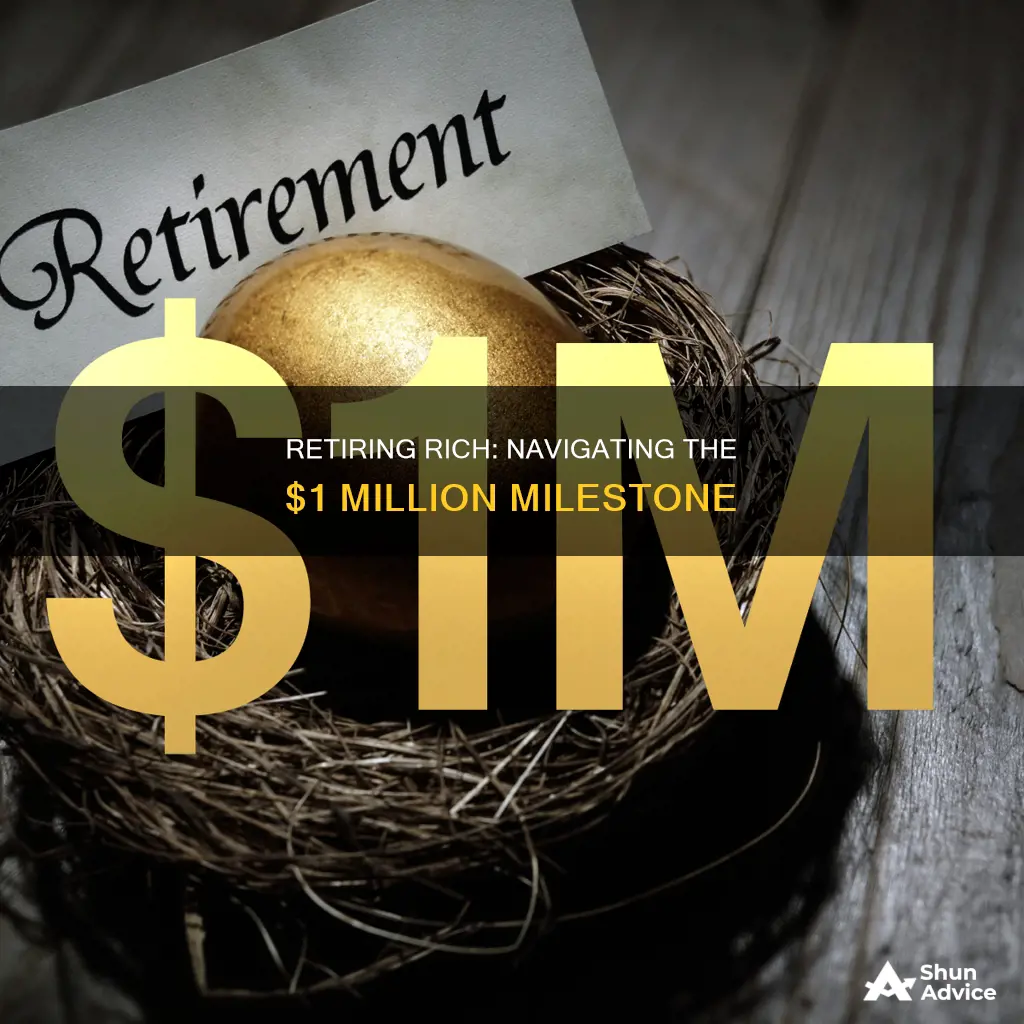
Retiring with $1 million in investible assets is a dream for many, but is it enough?
The short answer is: it depends.
For some, $1 million is more than enough to live a comfortable retirement. For others, it's not even close. The amount of money you need to retire comfortably depends on several factors, including your desired retirement lifestyle, risk tolerance, health, and life expectancy.
1. Desired retirement lifestyle: Do you plan to travel extensively, dine at expensive restaurants, or pursue expensive hobbies? Or do you envision a more frugal retirement? Your desired retirement lifestyle will significantly impact how much money you need. As a rule of thumb, retirees typically need about 80% of their pre-retirement income to sustain their lifestyle.
2. Risk tolerance and rate of return: How comfortable are you with investment risk? A more aggressive investment strategy may provide higher returns but comes with a higher risk of loss. Finding the right balance between risk and return is crucial to make your retirement nest egg last.
3. Health and life expectancy: Healthcare expenses can be significant, especially if you have poor health or experience major medical issues during retirement. The longer you live, the higher your healthcare costs are likely to be.
4. Location: The cost of living varies greatly depending on where you live. Relocating to an area with a lower cost of living or more retirement-friendly tax laws can help stretch your retirement savings.
5. Income sources: In addition to your retirement savings, consider other income sources such as Social Security, part-time work, or a pension. These additional income streams can reduce the amount you need to withdraw from your savings each year.
6. Inflation: Inflation erodes the purchasing power of your savings over time. A prolonged period of high inflation can significantly impact how long your retirement savings will last.
While $1 million may be a common benchmark for retirement, it's important to tailor your retirement plan to your specific needs and circumstances. Working with a financial advisor can help you make informed decisions and ensure your retirement savings last throughout your golden years.
| Characteristics | Values |
|---|---|
| Geography | The cost of living differs dramatically across the country. |
| Longevity | People can make an educated guess based on their health and family history. |
| Lifestyle | Retirees need to make smart spending choices. |
| Health care | The 2023 Fidelity Retiree Health Care Cost Estimate found an average 65-year-old couple retiring this year can expect to spend $315,000 on health care costs in retirement. |
| Long-term care | The Fidelity estimate doesn’t include long-term care, which could cost more than $115,000 a year for a private nursing home room. |
| Retirement income | Most people won't be living exclusively off their savings in retirement. |
| Asset mix | Ideally, it will be invested in a way that keeps up with inflation. |
| Investment risk | Retirees also need to take a close look at their portfolio if they want to know the answer to how long $1 million will last in retirement. |
| Inflation | A rising inflation rate will erode the purchasing power of money and result in retirees burning through their savings faster. |
What You'll Learn

Invest in a diversified portfolio of stocks
A diversified portfolio of stocks is a crucial component of retiring on $1 million in investible assets. Here are some detailed strategies and considerations for investing in a diversified portfolio of stocks:
Individual Asset Diversification
Investing in a range of assets within the stock asset class is essential. This can be achieved by buying a market index, such as the S&P 500 or the Russell 2000, which ensures a diverse mix of high- and low-risk stocks across various industries. Alternatively, you can consciously invest in complementary industries to spread your risk.
International Market Diversification
Investing in international markets is a wise strategy to mitigate country-specific risks. Different countries have diverse rules, regulations, and processes for investing, so it's important to be aware of these variations. By investing globally, you reduce the impact of market volatility and country-specific economic downturns.
Asset Class Diversification
Diversifying across multiple asset classes is another critical aspect. Traditional investments such as stocks, bonds, and cash should be complemented by alternative investments, which often operate in the private market and are unregulated. Examples of alternative investments include hedge funds, private equity, real estate, debt investing, commodities, collectibles, and structured products. These alternative investments tend to have a low correlation with traditional assets, providing a hedge against market downturns.
Time Horizon and Liquidity
When constructing your portfolio, consider the time horizon and liquidity of each investment. Traditional investments like stocks, bonds, and cash are typically liquid and don't have a set time horizon. In contrast, alternative investments are generally illiquid and have longer time horizons. For example, private equity investments usually have a time horizon of around ten years.
Markets and Industries
Diversifying across various industries and markets is vital. When investing in private equity or debt, explore industry trends and select companies with complementary performance. For real estate investments, diversify your capital across different types of properties and geographic locations to reduce concentration risk.
Risks and Potential Threats
Understanding the risks and potential threats associated with each investment is essential. Alternative investments with longer time horizons often have lower risk due to the market's ability to correct itself over time. However, if the investment is a physical asset, a longer time horizon increases the risk of damage, theft, or loss.
Managing Risk
It's important to note that diversification does not guarantee profit or eliminate risk entirely. The goal is to balance risk and reward. Diversification helps reduce volatility and the potential for significant losses by spreading your investments across multiple assets and industries.
In conclusion, by following these strategies and considerations, you can effectively invest in a diversified portfolio of stocks, which is a crucial step towards achieving a comfortable retirement with $1 million in investible assets.
Investments: Where is the Money Going?
You may want to see also

Consider buying a home
Homeownership is an effective way to build wealth. Research shows that buying a home typically carries an internal rate of return of between 7 and 14 per cent, depending on where you buy and what your financing decisions are.
From an internal rate of return (IRR) perspective, making principal payments on your mortgage will generally carry a higher rate of return than investing in bonds. If you have a mortgage and your portfolio is 70 per cent stocks and 30 per cent bonds, there's a mathematical argument to be made for being 100 per cent stocks and applying the bond portion towards mortgage principal.
If you are a first-time homebuyer, you will likely have a house that is a much higher percentage of your net worth. This is normal. The goal is to get your primary residence under 30 per cent of your net worth over time.
If you are a veteran home buyer, you can use 30 per cent of your net worth as a barometer for your next house purchase. For example, if you are a first-time homebuyer and have a $300,000 net worth with a $100,000 household income, the bank says you can borrow up to $350,000 to buy a home. You decide to borrow $280,000 and put down $80,000 on a $360,000 home. A $360,000 primary residence equates to 120 per cent of your net worth. This is a common scenario most first-time homebuyers face. With a $1,300 a month mortgage and an $8,333 a month gross income, you should have no problem affording your house.
With 30 per cent of net worth as the ideal primary residence value, you have a target net worth of $1,200,000 ($360,000 / 30 per cent), based on the original purchase price of your primary residence. Your goal will be to earn, save, and invest as much as possible to boost your non-primary residence net worth to $900,000 ($1.2 million target minus existing $300,000 net worth).
If you can save $10,000 a year for 26 years and earn an 8.3 per cent annual return, you'll be able to accumulate a $900,000 non-primary residence net worth. If you boosted your savings by $20,000 on average, you could accumulate a $926,000 non-primary residence net worth in only 19 years, assuming the same 8.3 per cent annual return.
Depending on how much your primary residence appreciates in value during this time, you may have to shoot for an even higher net worth. Challenge yourself to keep actively building wealth.
If you end up following the 30/30/3 house-buying rule, then you will most likely achieve the ideal primary residence value as a percentage of net worth within 15 years. The idea is to buy responsibly and grow into your home as you get wealthier. This way, you get to live a better life while using other people's money.
If you buy your first home at 30, by 45 you should be sitting pretty. Your wealth should have grown tremendously during this time period. So should your home's value. Within 15 years, you should feel very at ease with the ongoing cost of owning your home.
Your 40s and 50s are when you will likely start to tire from the work grind. Your risk tolerance may also decline given you may have parents and children to care for. As a result, having your primary residence equal to the minority of your net worth is a prudent goal.
However, if your net worth grows much quicker than the average person and your home's value, then you may consider buying an even nicer home. This is a predicament many people are now facing thanks to a bull market since 2009. Many people find they live in their homes for less time than they originally planned.
Enjoy your forever home for now; it will likely change.
Student Loans vs. Investing: Navigating the Trade-offs
You may want to see also

Generate recurring income
Generating Recurring Income
Generating recurring income is the second pillar of traditional retirement. Social security is the classic source of annuitized income. Despite the warnings from the media, the system can be supported with modest payroll tax increases. However, you have to be of traditional retirement age to benefit, and you have to have paid into the system earlier in life.
- Real estate investing: You can pay off your own mortgage, and then when you retire, you have no mortgage and the rent will mostly drop down to your net income. The real estate approach works best when you have a diversified portfolio of properties.
- Annuities: Sometimes annuities are loaded with fees and are bad products, but good annuities rely on the same principles as social security. Pro athletes sometimes buy specialized annuities to help spread out the earnings from their short but profitable careers over the rest of their lives.
- Passive income-oriented businesses: It's not uncommon for early retirees to shift to more pleasant work after exiting the corporate world. Online publishing is a good business model, for reference. The operating margins are high, and there are no requirements that you must have employees or inventory to deal with.
- Dividends: Many retirees look to dividend stocks to generate recurring income. While it's not a perfect strategy, the approach often works well for generating ~3+ percent annual income as a percentage of your nest egg.
- Selling puts and writing covered calls: This can work to supplement dividend investing if you know all the theory and the economics behind it.
Other Considerations
- Risk management: Take too little risk, and you'll run out of money. Take too much, and you may also run out. You have to accept calculated risks to achieve your goals in the long run.
- Asset-liability mismatch: If your assets are in the financial markets and your bills need to be paid in cash, then you have an asset-liability mismatch. If you live solely off of the stock market and the market crashes, you're in trouble because your income and assets are down, but your liabilities are probably unchanged.
The Savvy Investor's Guide: Navigating the World of Investing
You may want to see also

Take calculated risks
When it comes to retiring on $1 million in investible assets, taking calculated risks is an important aspect of your financial strategy. Here are some key considerations and guidelines to help you navigate this complex topic:
Understanding Risk Management
The essence of risk management is to make informed decisions about how much risk to take and how much volatility to accept in your investment portfolio. It's important to distinguish between risk and danger; while danger should always be minimised, risk can be managed and accepted in a calculated manner. This involves assessing your risk tolerance and financial goals to determine the appropriate level of risk for your situation.
Asset Allocation and Diversification
Diversifying your investments across different asset classes, such as stocks, bonds, real estate, and alternative investments, is crucial for managing risk effectively. By not putting all your eggs in one basket, you reduce the impact of any single investment or market downturn. Consider your overall asset allocation and ensure it aligns with your risk tolerance and financial goals. Diversification within each asset class is also important; for example, investing in a range of stocks from different sectors or countries can help mitigate specific risks associated with a particular industry or region.
Long-Term Perspective
Investing is a long-term endeavour, and taking a long-term perspective is essential when taking calculated risks. The stock market, for instance, tends to reward investors who remain invested for the long haul. While there will be ups and downs in the short term, historically, stock markets have trended upwards over time. Therefore, it's crucial to focus on long-term trends and avoid making impulsive decisions based on short-term market fluctuations.
Risk and Return Trade-off
When taking calculated risks, it's important to understand the relationship between risk and return. Generally, taking on more risk can lead to higher potential returns, but it also increases the possibility of losses. Assess your risk tolerance and financial goals to determine the appropriate balance between risk and return for your situation. Diversification and asset allocation can help manage this trade-off by spreading risk across different investments.
Active Risk Management
Effective risk management requires ongoing attention and adjustments. Regularly review and rebalance your investment portfolio to ensure it aligns with your risk tolerance and financial goals. Stay informed about market trends, economic conditions, and the performance of your investments. By actively managing your portfolio, you can take advantage of new opportunities and mitigate potential risks.
Professional Guidance
Consider seeking guidance from a qualified financial advisor or investment professional. They can provide personalised advice based on your circumstances, goals, and risk tolerance. These professionals can help you navigate the complexities of investing, including risk management, asset allocation, and diversification. Their expertise can be invaluable in helping you make informed decisions and take calculated risks.
Investments: How Much is Too Much?
You may want to see also

Plan for healthcare costs
Healthcare costs can be one of the biggest expenses a person faces in retirement. A retired couple, both aged 65, could face long-term medical expenses of approximately $315,000, according to the 2023 Fidelity Retiree Healthcare Cost Estimate. This sum does not include long-term care, over-the-counter medications, or dental services.
It is important to understand and plan for growing medical costs, whether you are early in your career, close to retirement, or already transitioning out of the workforce.
Medicare may pay for some healthcare costs in retirement but does not cover all of them. For example, it does not cover long-term care, and without a Part D prescription drug policy, it does not cover medications. Parts A and B do not cover dental and vision care, so you will need to budget for deductibles, premiums, and other out-of-pocket costs.
If you are not yet enrolled in Medicare, you can save money for healthcare costs with a Health Savings Account (HSA). HSAs can be used to pay for certain medical premiums, including Medicare premiums and long-term care insurance premiums. These are available with high-deductible health plans (HDHPs) and offer triple tax advantages: deductible contributions and tax-free withdrawals for qualified medical expenses.
Long-term care insurance is another way to fill the gap left by Medicare. This type of policy can pay a monthly benefit toward long-term care for a specified amount of time, usually between two and five years, or for the remainder of your lifetime. Long-term care insurance premiums may not be affordable for everyone, but an alternative is buying a life insurance policy with a long-term care rider.
If you do not have coverage for dental expenses via Medicare Advantage, you may also consider a standalone dental insurance plan. Many plans focus on the types of coverage that retirees need, including crowns, root canals, dentures, and tooth replacements.
While Medicare will pay about two-thirds of your medical costs, out-of-pocket healthcare expenses like premiums, co-pays, and deductibles can add up. A 55-year-old couple today can expect to pay more than $1 million for healthcare costs during their retirement.
Medicare Parts A and B, known as Original Medicare, cover a portion of hospital stays and medical services but not vision, hearing, or dental care; prescription drugs; or medical care outside the US. So, you may want to add a drug plan (Medicare Part D) and a Medicare Supplement Insurance Policy, commonly known as Medigap, which can help cover out-of-pocket costs as long as you have Original Medicare.
While there is no premium for Medicare Part A, there is a $1,632 deductible in 2024 for each inpatient hospital benefit period, before Medicare starts to pay. There is no limit to the number of benefit periods that can take place in a year. This means that you could pay the deductible amount many times if you have multiple hospital stays during a year.
The monthly premium for Medicare Part B is $174.70 in 2024, or higher depending on your income. You will pay the higher premium if your modified adjusted gross income (AGI) is more than $103,000 (from your tax return from two years prior), if you file an individual tax return or are married and file separately, or if your AGI is $206,000 if you are married and file a joint tax return. The higher monthly premium costs range from $244.60 to $594 based on income.
Medicare Part D premiums can also be impacted by income. The monthly cost, in addition to the plan premium, can range from $12.90 to $81.50.
Unless your employer offers retiree coverage, you will need to consider other health insurance options so that you do not go without coverage until you are Medicare-eligible. Your options include:
- Joining your partner's plan if they are still working or taking on a new job that provides you with healthcare benefits.
- Sticking with your employer's insurance plan under COBRA (the Consolidated Omnibus Budget Reconciliation Act) for up to 18 months.
- Purchasing health insurance directly from a company or through an insurance broker or purchasing health insurance on the government-managed exchange.
- Purchasing a high-deductible health plan that meets federal tax standards, permitting you to open an HSA.
Young Investors: Excited or Apprehensive?
You may want to see also
Frequently asked questions
$10 million is the ideal net worth for retirement. This amount of money will allow you to live a comfortable life without having to worry about finances. However, it is important to note that the cost of living varies depending on location, so this number may need to be adjusted accordingly.
Having a paid-off home is one of the three pillars of a successful retirement, along with recurring income and long-term investments for capital gains. Owning your home outright helps to solve the two fundamental challenges of retirement: managing liabilities and reducing expenses.
There are several ways to generate recurring income, including social security, real estate investing, annuities, passive income-oriented businesses, and dividends. It is important to have a diverse portfolio of income streams to ensure a comfortable retirement.
The stock market is a great way to invest for the long term and take advantage of its inherent volatility. By investing in stocks, you can increase your wealth over time and use the profits to pay for larger expenses.







